Health Care and Inequality: Examining Disparities in Scotland
VerifiedAdded on 2022/10/19
|8
|1694
|26
Report
AI Summary
This report delves into the critical issue of healthcare inequality in Scotland, analyzing the disparities in health outcomes between different regions and socio-economic groups. It examines data comparing urban and rural areas, highlighting differences in life expectancy and access to resources. The report explores the causes of these inequalities, including variations in income, power, and resource allocation, and discusses the impact of these factors on mortality rates and overall public health. Furthermore, it investigates the role of behavior, culture, and social determinants in shaping health outcomes. The analysis includes recommendations to address these disparities, such as information campaigns, environmental changes, and legislative controls. The report concludes by emphasizing the importance of standardized resource distribution to achieve health equity across all regions of Scotland, while acknowledging the influence of political decisions and priorities on health inequality.
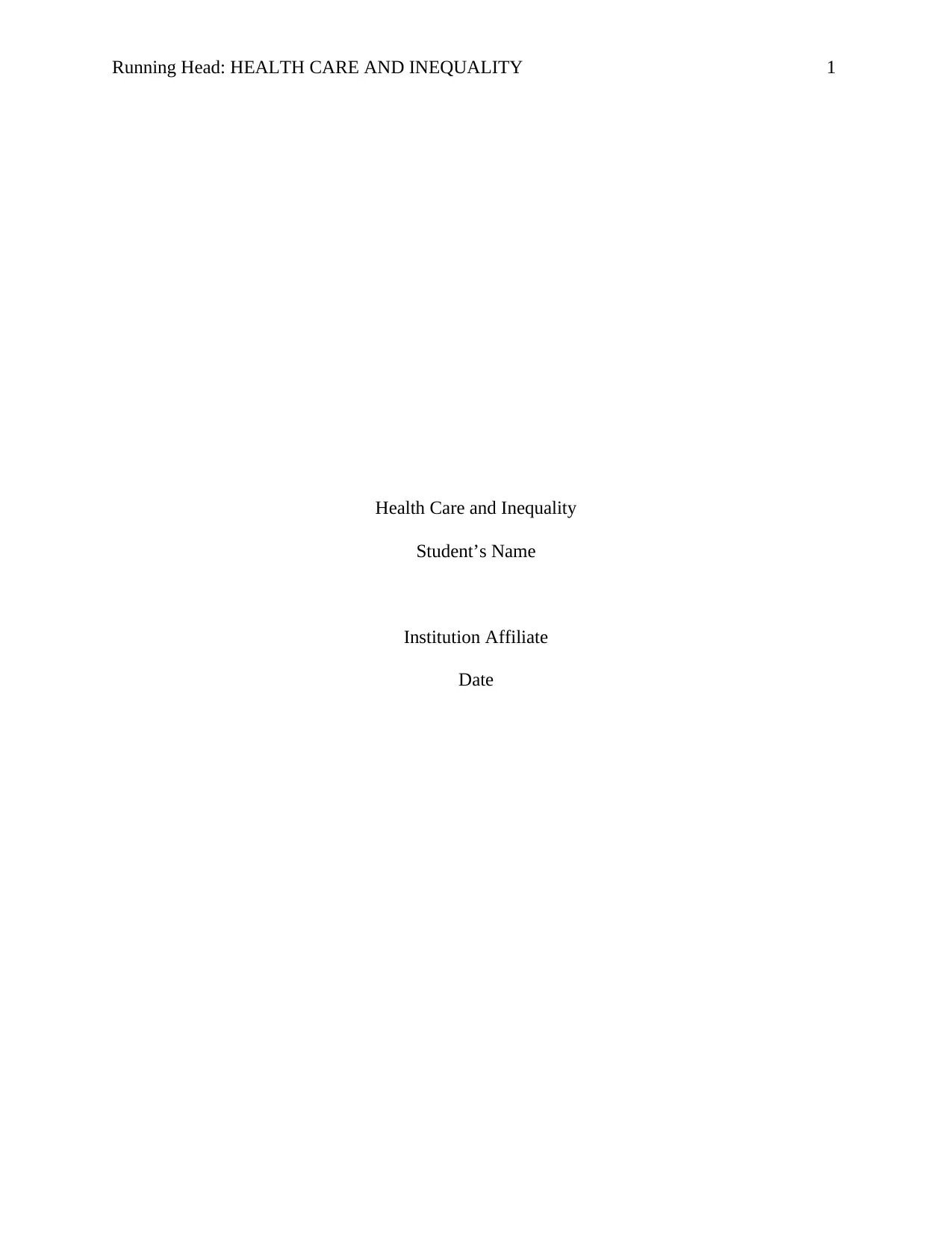
Running Head: HEALTH CARE AND INEQUALITY 1
Health Care and Inequality
Student’s Name
Institution Affiliate
Date
Health Care and Inequality
Student’s Name
Institution Affiliate
Date
Paraphrase This Document
Need a fresh take? Get an instant paraphrase of this document with our AI Paraphraser
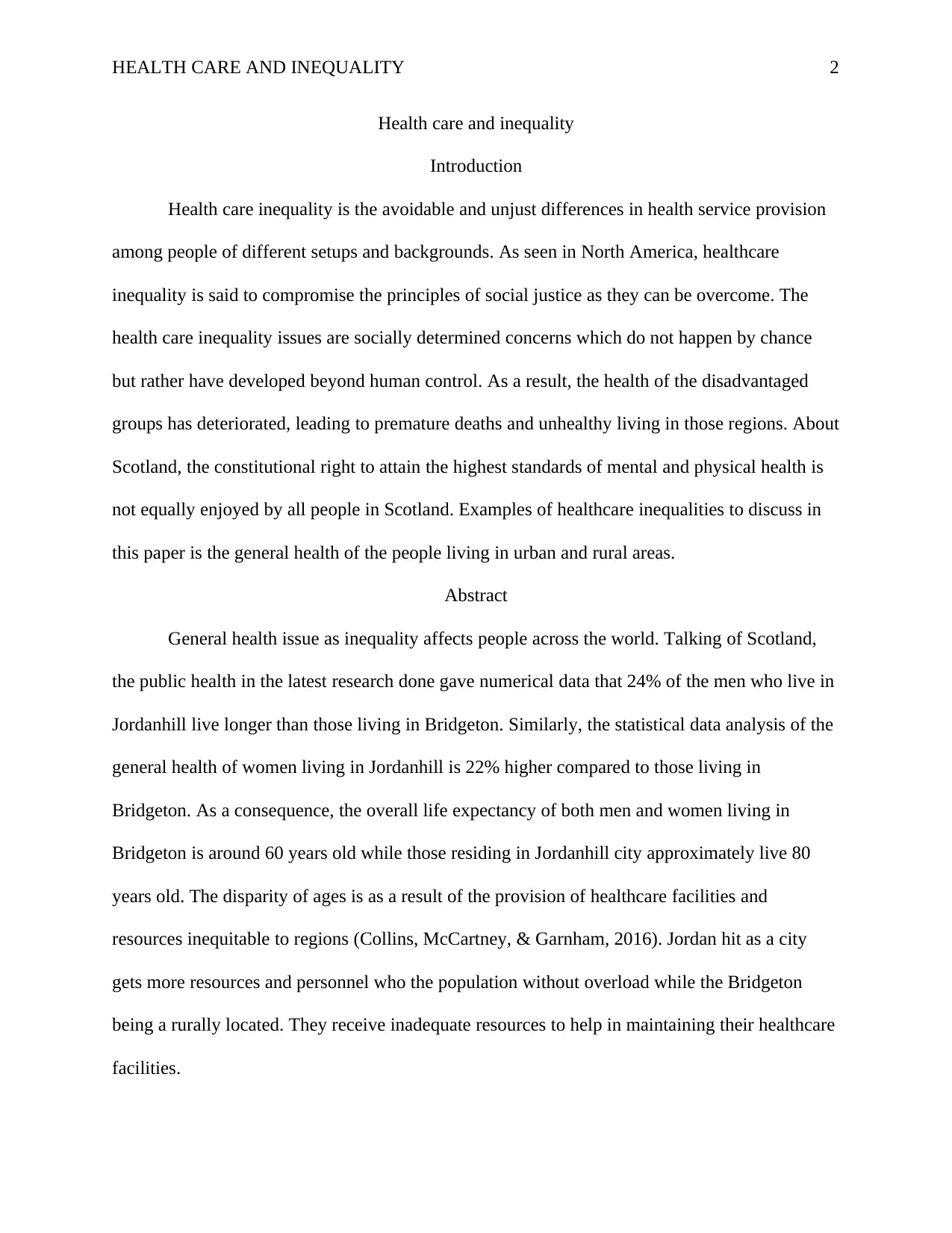
HEALTH CARE AND INEQUALITY 2
Health care and inequality
Introduction
Health care inequality is the avoidable and unjust differences in health service provision
among people of different setups and backgrounds. As seen in North America, healthcare
inequality is said to compromise the principles of social justice as they can be overcome. The
health care inequality issues are socially determined concerns which do not happen by chance
but rather have developed beyond human control. As a result, the health of the disadvantaged
groups has deteriorated, leading to premature deaths and unhealthy living in those regions. About
Scotland, the constitutional right to attain the highest standards of mental and physical health is
not equally enjoyed by all people in Scotland. Examples of healthcare inequalities to discuss in
this paper is the general health of the people living in urban and rural areas.
Abstract
General health issue as inequality affects people across the world. Talking of Scotland,
the public health in the latest research done gave numerical data that 24% of the men who live in
Jordanhill live longer than those living in Bridgeton. Similarly, the statistical data analysis of the
general health of women living in Jordanhill is 22% higher compared to those living in
Bridgeton. As a consequence, the overall life expectancy of both men and women living in
Bridgeton is around 60 years old while those residing in Jordanhill city approximately live 80
years old. The disparity of ages is as a result of the provision of healthcare facilities and
resources inequitable to regions (Collins, McCartney, & Garnham, 2016). Jordan hit as a city
gets more resources and personnel who the population without overload while the Bridgeton
being a rurally located. They receive inadequate resources to help in maintaining their healthcare
facilities.
Health care and inequality
Introduction
Health care inequality is the avoidable and unjust differences in health service provision
among people of different setups and backgrounds. As seen in North America, healthcare
inequality is said to compromise the principles of social justice as they can be overcome. The
health care inequality issues are socially determined concerns which do not happen by chance
but rather have developed beyond human control. As a result, the health of the disadvantaged
groups has deteriorated, leading to premature deaths and unhealthy living in those regions. About
Scotland, the constitutional right to attain the highest standards of mental and physical health is
not equally enjoyed by all people in Scotland. Examples of healthcare inequalities to discuss in
this paper is the general health of the people living in urban and rural areas.
Abstract
General health issue as inequality affects people across the world. Talking of Scotland,
the public health in the latest research done gave numerical data that 24% of the men who live in
Jordanhill live longer than those living in Bridgeton. Similarly, the statistical data analysis of the
general health of women living in Jordanhill is 22% higher compared to those living in
Bridgeton. As a consequence, the overall life expectancy of both men and women living in
Bridgeton is around 60 years old while those residing in Jordanhill city approximately live 80
years old. The disparity of ages is as a result of the provision of healthcare facilities and
resources inequitable to regions (Collins, McCartney, & Garnham, 2016). Jordan hit as a city
gets more resources and personnel who the population without overload while the Bridgeton
being a rurally located. They receive inadequate resources to help in maintaining their healthcare
facilities.
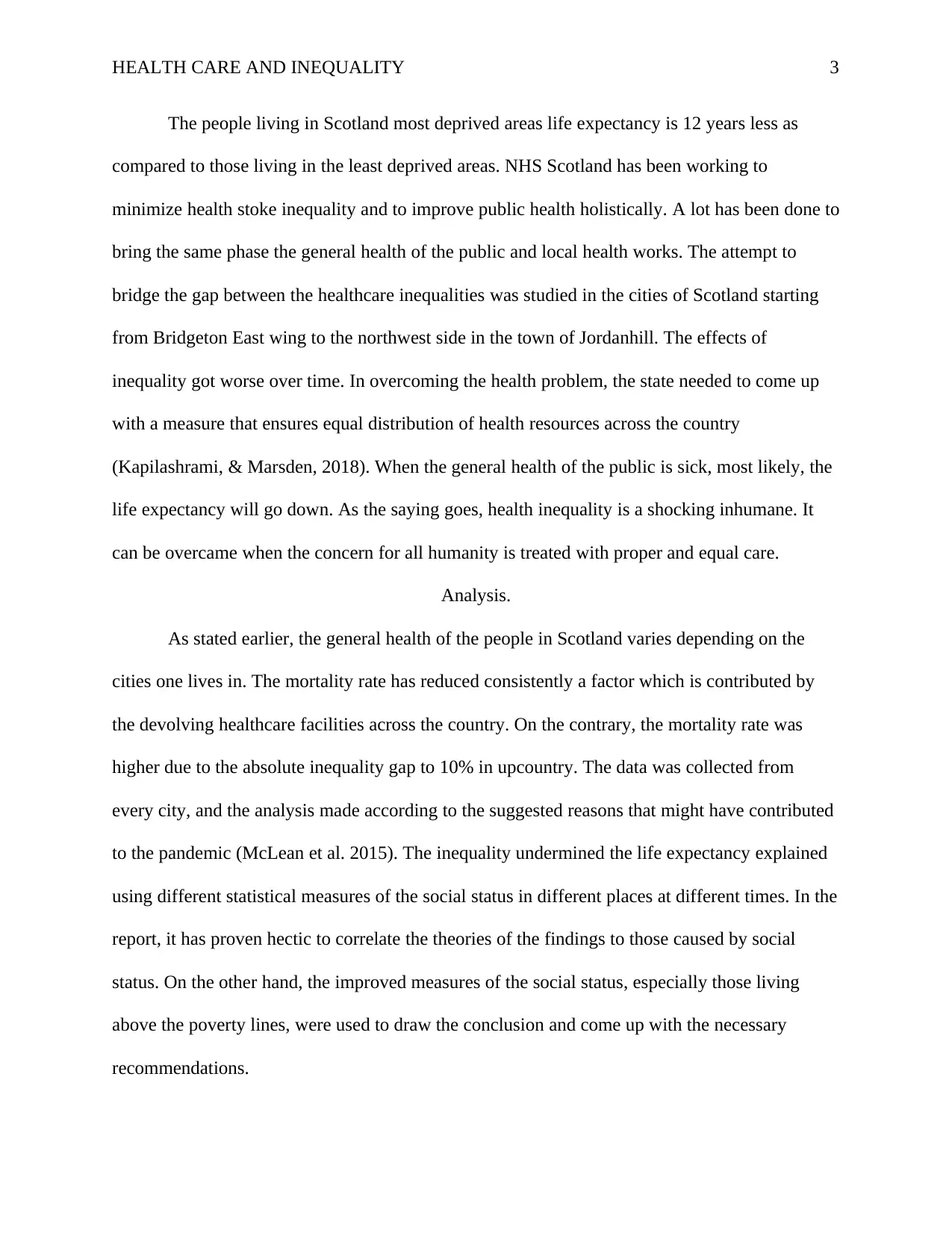
HEALTH CARE AND INEQUALITY 3
The people living in Scotland most deprived areas life expectancy is 12 years less as
compared to those living in the least deprived areas. NHS Scotland has been working to
minimize health stoke inequality and to improve public health holistically. A lot has been done to
bring the same phase the general health of the public and local health works. The attempt to
bridge the gap between the healthcare inequalities was studied in the cities of Scotland starting
from Bridgeton East wing to the northwest side in the town of Jordanhill. The effects of
inequality got worse over time. In overcoming the health problem, the state needed to come up
with a measure that ensures equal distribution of health resources across the country
(Kapilashrami, & Marsden, 2018). When the general health of the public is sick, most likely, the
life expectancy will go down. As the saying goes, health inequality is a shocking inhumane. It
can be overcame when the concern for all humanity is treated with proper and equal care.
Analysis.
As stated earlier, the general health of the people in Scotland varies depending on the
cities one lives in. The mortality rate has reduced consistently a factor which is contributed by
the devolving healthcare facilities across the country. On the contrary, the mortality rate was
higher due to the absolute inequality gap to 10% in upcountry. The data was collected from
every city, and the analysis made according to the suggested reasons that might have contributed
to the pandemic (McLean et al. 2015). The inequality undermined the life expectancy explained
using different statistical measures of the social status in different places at different times. In the
report, it has proven hectic to correlate the theories of the findings to those caused by social
status. On the other hand, the improved measures of the social status, especially those living
above the poverty lines, were used to draw the conclusion and come up with the necessary
recommendations.
The people living in Scotland most deprived areas life expectancy is 12 years less as
compared to those living in the least deprived areas. NHS Scotland has been working to
minimize health stoke inequality and to improve public health holistically. A lot has been done to
bring the same phase the general health of the public and local health works. The attempt to
bridge the gap between the healthcare inequalities was studied in the cities of Scotland starting
from Bridgeton East wing to the northwest side in the town of Jordanhill. The effects of
inequality got worse over time. In overcoming the health problem, the state needed to come up
with a measure that ensures equal distribution of health resources across the country
(Kapilashrami, & Marsden, 2018). When the general health of the public is sick, most likely, the
life expectancy will go down. As the saying goes, health inequality is a shocking inhumane. It
can be overcame when the concern for all humanity is treated with proper and equal care.
Analysis.
As stated earlier, the general health of the people in Scotland varies depending on the
cities one lives in. The mortality rate has reduced consistently a factor which is contributed by
the devolving healthcare facilities across the country. On the contrary, the mortality rate was
higher due to the absolute inequality gap to 10% in upcountry. The data was collected from
every city, and the analysis made according to the suggested reasons that might have contributed
to the pandemic (McLean et al. 2015). The inequality undermined the life expectancy explained
using different statistical measures of the social status in different places at different times. In the
report, it has proven hectic to correlate the theories of the findings to those caused by social
status. On the other hand, the improved measures of the social status, especially those living
above the poverty lines, were used to draw the conclusion and come up with the necessary
recommendations.
⊘ This is a preview!⊘
Do you want full access?
Subscribe today to unlock all pages.

Trusted by 1+ million students worldwide
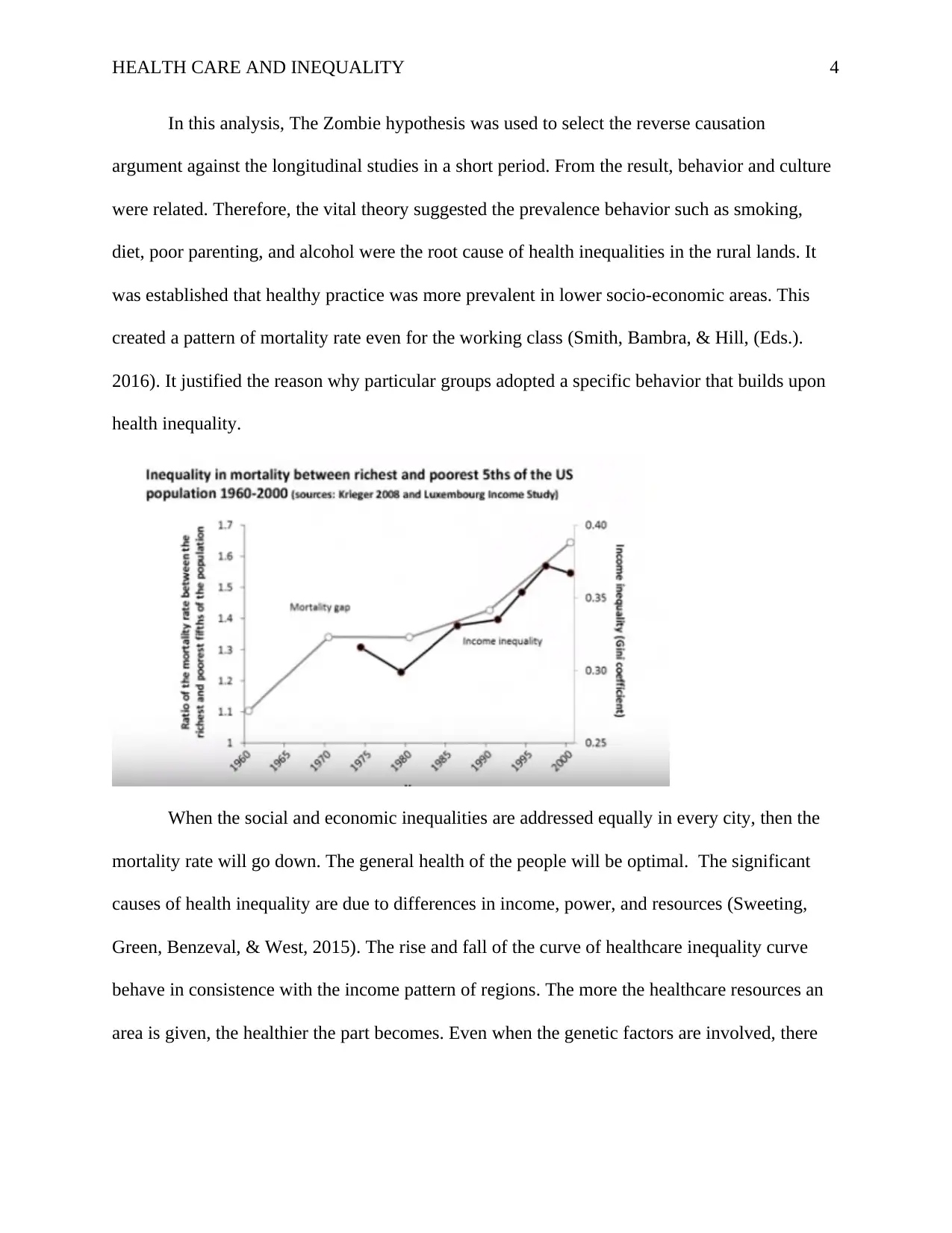
HEALTH CARE AND INEQUALITY 4
In this analysis, The Zombie hypothesis was used to select the reverse causation
argument against the longitudinal studies in a short period. From the result, behavior and culture
were related. Therefore, the vital theory suggested the prevalence behavior such as smoking,
diet, poor parenting, and alcohol were the root cause of health inequalities in the rural lands. It
was established that healthy practice was more prevalent in lower socio-economic areas. This
created a pattern of mortality rate even for the working class (Smith, Bambra, & Hill, (Eds.).
2016). It justified the reason why particular groups adopted a specific behavior that builds upon
health inequality.
When the social and economic inequalities are addressed equally in every city, then the
mortality rate will go down. The general health of the people will be optimal. The significant
causes of health inequality are due to differences in income, power, and resources (Sweeting,
Green, Benzeval, & West, 2015). The rise and fall of the curve of healthcare inequality curve
behave in consistence with the income pattern of regions. The more the healthcare resources an
area is given, the healthier the part becomes. Even when the genetic factors are involved, there
In this analysis, The Zombie hypothesis was used to select the reverse causation
argument against the longitudinal studies in a short period. From the result, behavior and culture
were related. Therefore, the vital theory suggested the prevalence behavior such as smoking,
diet, poor parenting, and alcohol were the root cause of health inequalities in the rural lands. It
was established that healthy practice was more prevalent in lower socio-economic areas. This
created a pattern of mortality rate even for the working class (Smith, Bambra, & Hill, (Eds.).
2016). It justified the reason why particular groups adopted a specific behavior that builds upon
health inequality.
When the social and economic inequalities are addressed equally in every city, then the
mortality rate will go down. The general health of the people will be optimal. The significant
causes of health inequality are due to differences in income, power, and resources (Sweeting,
Green, Benzeval, & West, 2015). The rise and fall of the curve of healthcare inequality curve
behave in consistence with the income pattern of regions. The more the healthcare resources an
area is given, the healthier the part becomes. Even when the genetic factors are involved, there
Paraphrase This Document
Need a fresh take? Get an instant paraphrase of this document with our AI Paraphraser

HEALTH CARE AND INEQUALITY 5
would still be significant inequality in mortality rate. Also, the social class which proves to be
substantial depending on changing contextual factors.
Recommendations
The following are the recommendations that arrived at so address the general health inequality
issue in Scotland (Tod et al. 2019).
Information based campaign should be conducted primarily in the most affected cities so
that the general public is made aware of the significant causes of health inequality.
The national government incorporation with the health department should enhance
structural changes in the environment such as separation of pedestrians and vehicles,
installation of the smoking alarms and child-resistant containers, among others.
Health inequality concept such as school-based alcohol and anti-smoking programs
should be introduced in elementary schools. This will help the students to familiarize
with the idea at early stages to help control the problem in the future generation.
The legislative and regulatory controls should be imposed, such as lowering the speed
limits, no drunken driving, house building standards, smoking bans in workplaces, and
child-resistant loan scheme and legislation.
Conclusion
From the analysis above, the structural explanations can best fit in explaining the causes
of health inequality. Besides, behavioral and cultural theories can be relevant but are not much
reliant as the blames are on the poor people since their behavior, cultures, and skills are
damaging. The selection theory may not explain much and therefore, and health inequalities are
would still be significant inequality in mortality rate. Also, the social class which proves to be
substantial depending on changing contextual factors.
Recommendations
The following are the recommendations that arrived at so address the general health inequality
issue in Scotland (Tod et al. 2019).
Information based campaign should be conducted primarily in the most affected cities so
that the general public is made aware of the significant causes of health inequality.
The national government incorporation with the health department should enhance
structural changes in the environment such as separation of pedestrians and vehicles,
installation of the smoking alarms and child-resistant containers, among others.
Health inequality concept such as school-based alcohol and anti-smoking programs
should be introduced in elementary schools. This will help the students to familiarize
with the idea at early stages to help control the problem in the future generation.
The legislative and regulatory controls should be imposed, such as lowering the speed
limits, no drunken driving, house building standards, smoking bans in workplaces, and
child-resistant loan scheme and legislation.
Conclusion
From the analysis above, the structural explanations can best fit in explaining the causes
of health inequality. Besides, behavioral and cultural theories can be relevant but are not much
reliant as the blames are on the poor people since their behavior, cultures, and skills are
damaging. The selection theory may not explain much and therefore, and health inequalities are
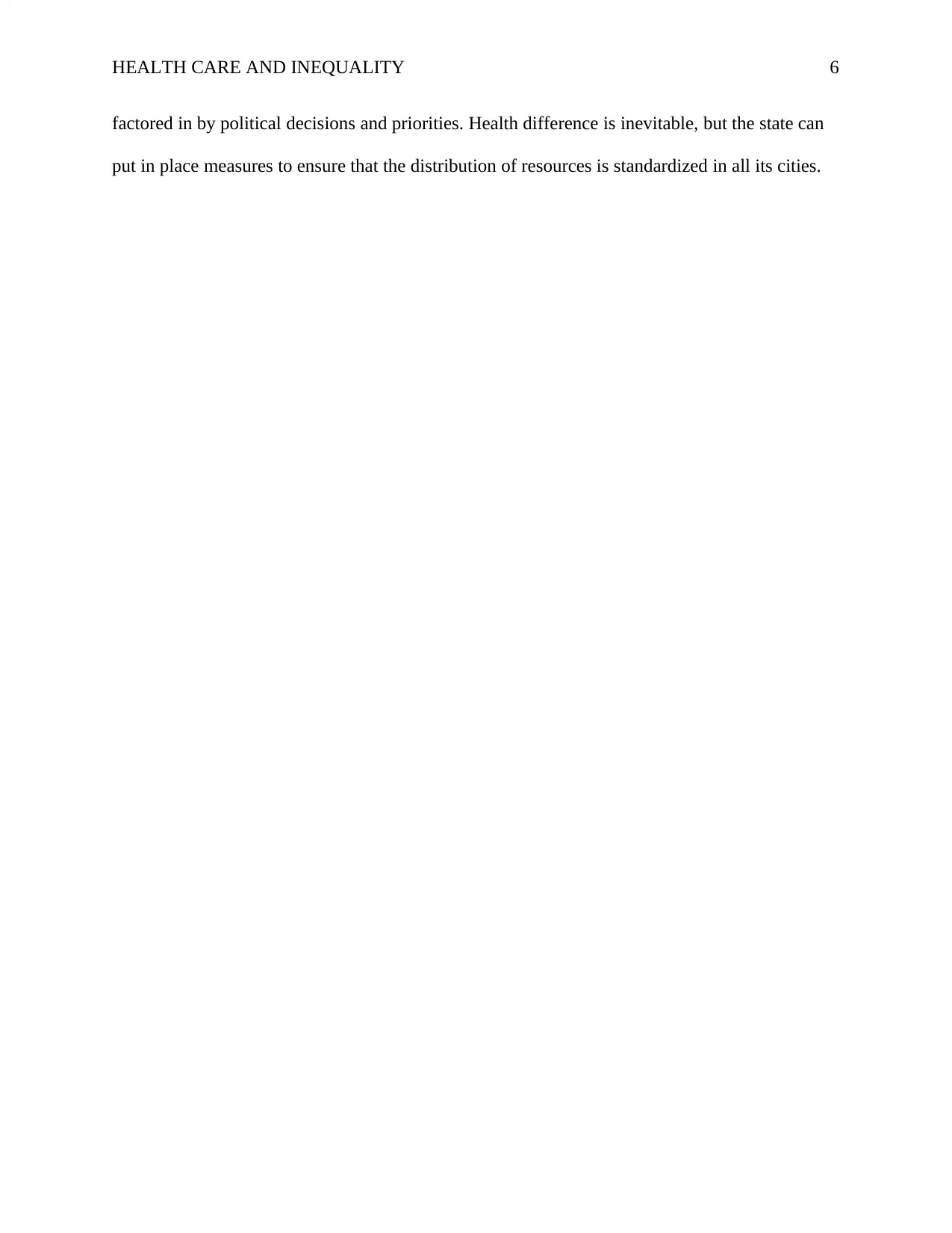
HEALTH CARE AND INEQUALITY 6
factored in by political decisions and priorities. Health difference is inevitable, but the state can
put in place measures to ensure that the distribution of resources is standardized in all its cities.
factored in by political decisions and priorities. Health difference is inevitable, but the state can
put in place measures to ensure that the distribution of resources is standardized in all its cities.
⊘ This is a preview!⊘
Do you want full access?
Subscribe today to unlock all pages.

Trusted by 1+ million students worldwide
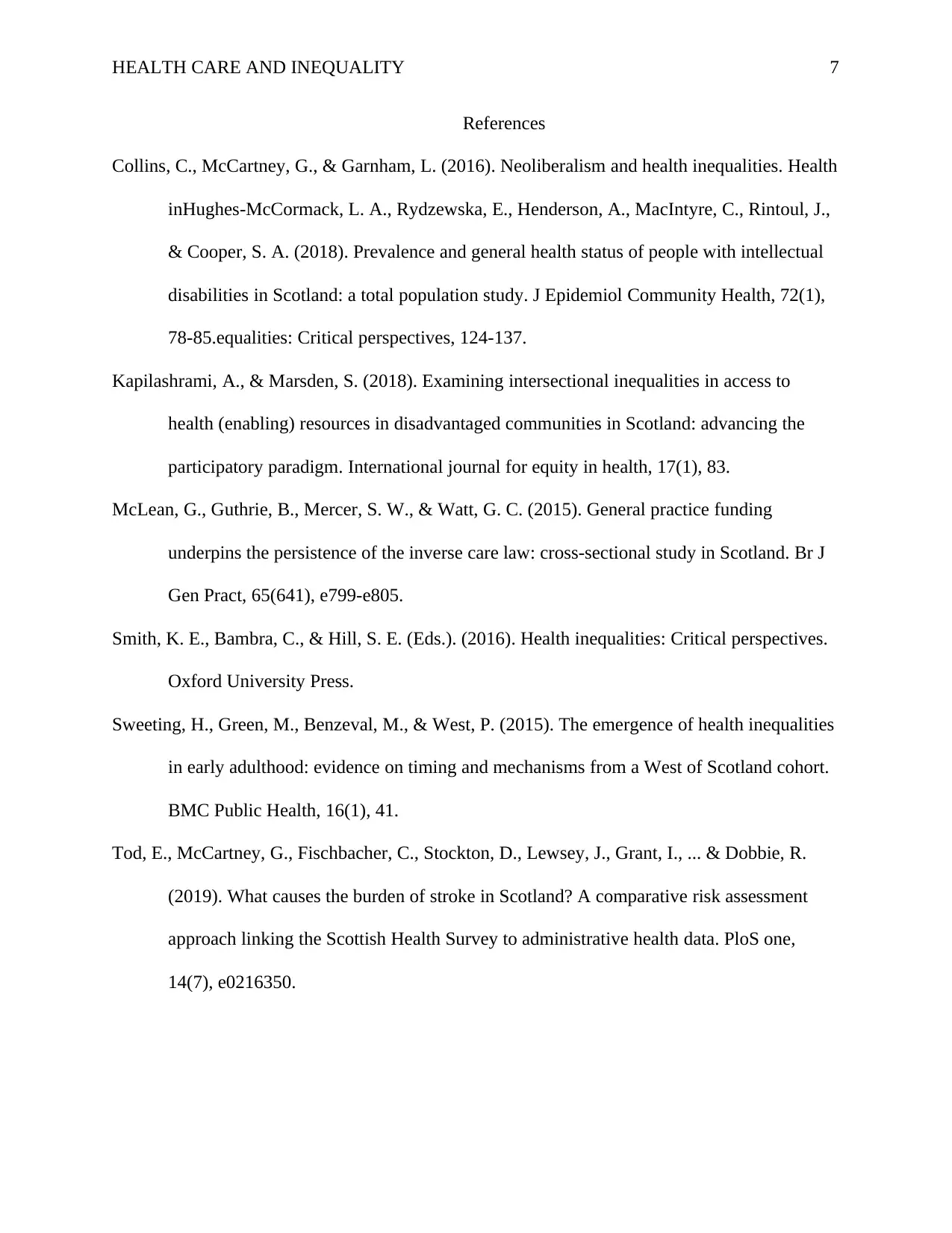
HEALTH CARE AND INEQUALITY 7
References
Collins, C., McCartney, G., & Garnham, L. (2016). Neoliberalism and health inequalities. Health
inHughes-McCormack, L. A., Rydzewska, E., Henderson, A., MacIntyre, C., Rintoul, J.,
& Cooper, S. A. (2018). Prevalence and general health status of people with intellectual
disabilities in Scotland: a total population study. J Epidemiol Community Health, 72(1),
78-85.equalities: Critical perspectives, 124-137.
Kapilashrami, A., & Marsden, S. (2018). Examining intersectional inequalities in access to
health (enabling) resources in disadvantaged communities in Scotland: advancing the
participatory paradigm. International journal for equity in health, 17(1), 83.
McLean, G., Guthrie, B., Mercer, S. W., & Watt, G. C. (2015). General practice funding
underpins the persistence of the inverse care law: cross-sectional study in Scotland. Br J
Gen Pract, 65(641), e799-e805.
Smith, K. E., Bambra, C., & Hill, S. E. (Eds.). (2016). Health inequalities: Critical perspectives.
Oxford University Press.
Sweeting, H., Green, M., Benzeval, M., & West, P. (2015). The emergence of health inequalities
in early adulthood: evidence on timing and mechanisms from a West of Scotland cohort.
BMC Public Health, 16(1), 41.
Tod, E., McCartney, G., Fischbacher, C., Stockton, D., Lewsey, J., Grant, I., ... & Dobbie, R.
(2019). What causes the burden of stroke in Scotland? A comparative risk assessment
approach linking the Scottish Health Survey to administrative health data. PloS one,
14(7), e0216350.
References
Collins, C., McCartney, G., & Garnham, L. (2016). Neoliberalism and health inequalities. Health
inHughes-McCormack, L. A., Rydzewska, E., Henderson, A., MacIntyre, C., Rintoul, J.,
& Cooper, S. A. (2018). Prevalence and general health status of people with intellectual
disabilities in Scotland: a total population study. J Epidemiol Community Health, 72(1),
78-85.equalities: Critical perspectives, 124-137.
Kapilashrami, A., & Marsden, S. (2018). Examining intersectional inequalities in access to
health (enabling) resources in disadvantaged communities in Scotland: advancing the
participatory paradigm. International journal for equity in health, 17(1), 83.
McLean, G., Guthrie, B., Mercer, S. W., & Watt, G. C. (2015). General practice funding
underpins the persistence of the inverse care law: cross-sectional study in Scotland. Br J
Gen Pract, 65(641), e799-e805.
Smith, K. E., Bambra, C., & Hill, S. E. (Eds.). (2016). Health inequalities: Critical perspectives.
Oxford University Press.
Sweeting, H., Green, M., Benzeval, M., & West, P. (2015). The emergence of health inequalities
in early adulthood: evidence on timing and mechanisms from a West of Scotland cohort.
BMC Public Health, 16(1), 41.
Tod, E., McCartney, G., Fischbacher, C., Stockton, D., Lewsey, J., Grant, I., ... & Dobbie, R.
(2019). What causes the burden of stroke in Scotland? A comparative risk assessment
approach linking the Scottish Health Survey to administrative health data. PloS one,
14(7), e0216350.
Paraphrase This Document
Need a fresh take? Get an instant paraphrase of this document with our AI Paraphraser

HEALTH CARE AND INEQUALITY 8
Frank, J., Bromley, C., Doi, L., Estrade, M., Jepson, R., McAteer, J., ... & Williams, A. (2015).
Seven key investments for health equity across the lifecourse: Scotland versus the rest of
the UK. Social Science & Medicine, 140, 136-146.
Katikireddi, S. V., Cezard, G., Bhopal, R. S., Williams, L., Douglas, A., Millard, A., ... & Gruer,
L. (2018). Assessment of health care, hospital admissions, and mortality by ethnicity:
population-based cohort study of health-system performance in Scotland. The Lancet
Public Health, 3(5), e226-e236.
Frank, J., Bromley, C., Doi, L., Estrade, M., Jepson, R., McAteer, J., ... & Williams, A. (2015).
Seven key investments for health equity across the lifecourse: Scotland versus the rest of
the UK. Social Science & Medicine, 140, 136-146.
Katikireddi, S. V., Cezard, G., Bhopal, R. S., Williams, L., Douglas, A., Millard, A., ... & Gruer,
L. (2018). Assessment of health care, hospital admissions, and mortality by ethnicity:
population-based cohort study of health-system performance in Scotland. The Lancet
Public Health, 3(5), e226-e236.
1 out of 8
Related Documents
Your All-in-One AI-Powered Toolkit for Academic Success.
+13062052269
info@desklib.com
Available 24*7 on WhatsApp / Email
![[object Object]](/_next/static/media/star-bottom.7253800d.svg)
Unlock your academic potential
Copyright © 2020–2025 A2Z Services. All Rights Reserved. Developed and managed by ZUCOL.





